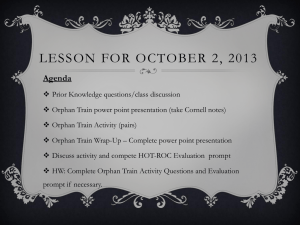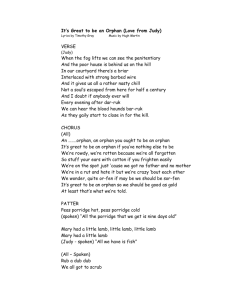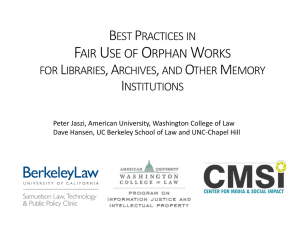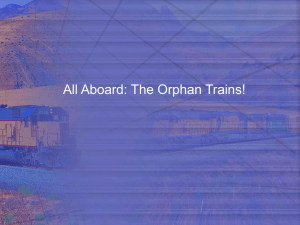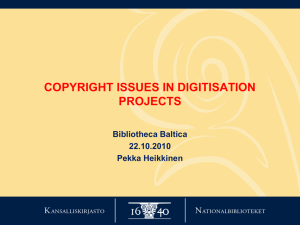File
advertisement
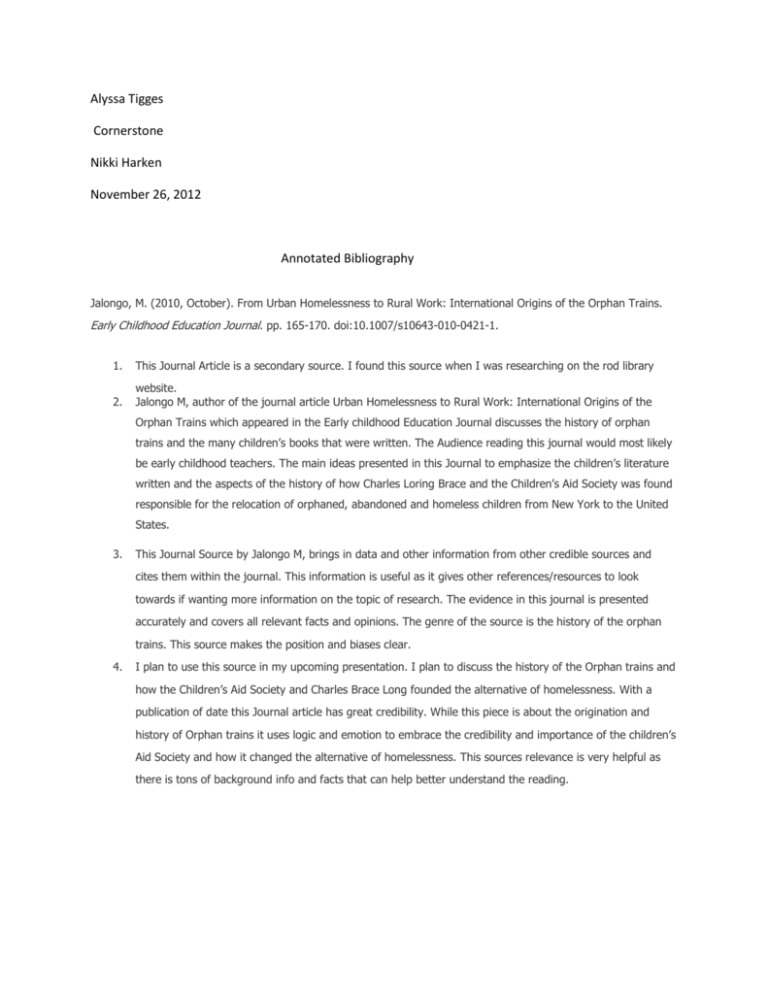
Alyssa Tigges Cornerstone Nikki Harken November 26, 2012 Annotated Bibliography Jalongo, M. (2010, October). From Urban Homelessness to Rural Work: International Origins of the Orphan Trains. Early Childhood Education Journal. pp. 165-170. doi:10.1007/s10643-010-0421-1. 1. This Journal Article is a secondary source. I found this source when I was researching on the rod library 2. website. Jalongo M, author of the journal article Urban Homelessness to Rural Work: International Origins of the Orphan Trains which appeared in the Early childhood Education Journal discusses the history of orphan trains and the many children’s books that were written. The Audience reading this journal would most likely be early childhood teachers. The main ideas presented in this Journal to emphasize the children’s literature written and the aspects of the history of how Charles Loring Brace and the Children’s Aid Society was found responsible for the relocation of orphaned, abandoned and homeless children from New York to the United States. 3. This Journal Source by Jalongo M, brings in data and other information from other credible sources and cites them within the journal. This information is useful as it gives other references/resources to look towards if wanting more information on the topic of research. The evidence in this journal is presented accurately and covers all relevant facts and opinions. The genre of the source is the history of the orphan trains. This source makes the position and biases clear. 4. I plan to use this source in my upcoming presentation. I plan to discuss the history of the Orphan trains and how the Children’s Aid Society and Charles Brace Long founded the alternative of homelessness. With a publication of date this Journal article has great credibility. While this piece is about the origination and history of Orphan trains it uses logic and emotion to embrace the credibility and importance of the children’s Aid Society and how it changed the alternative of homelessness. This sources relevance is very helpful as there is tons of background info and facts that can help better understand the reading. Judy, K., & USA, T. (n.d). Descendants track path of orphan trains. USA Today. 1. 2. This Newspaper article is a secondary source that I found on the Rod Library webpage after searching for Orphan trains by using the search engine EBSCO. Judy K, wrote the newspaper article Descendants track path of orphan trains. This article appeared in the USA today newspaper. In this article Judy writes about the history and stories of many children’s lives and the paths they took on the orphan trains. The audience towards this piece would end up being anyone who is wanting to know about the lives and challenges that orphan descendants went through. The main idea presented in this news article is all the stories of the descendants of the orphan trains. 3. USA today published this article by Judy K. The evidence in this piece would be all the people Judy credits and sites/interviews. The genre of the source is the stories and history of the many descendants that went through this. With the direct quotes from descendants of the orphan trains it is easier to understand the emotions of what they went through. 4. I would use this source in my presentation as a way to show the audience the feelings and emotions of the descendants. This is a credible source to use as I can talk about the stories and lives of the homeless descendants of the orphan trains. With the direct quotes and I can use them in my presentation to give examples on the lives of orphan trains. (1995, November 26). Homeless Children, Then and Now. New York Times. P.10 1. This Newspaper article is a secondary source that I found after searching Orphan trains on the University of Northern Iowa Rod Library Website. 2. Homeless children then and now, is an article that was published in the New York Times. In this article, it states back to the history of homeless children and also refers to the Children’s Aid society and the changes it made throughout the times. The audience of this article would be anyone who is trying to better understand the history of orphan trains and how it has changed over the years. 3. The evidence in this article support the authors claim. There are logical facts on the then vs. now aspect within the article. It gives credibility to the Children’s Aid Society and how it has changed and organized a change for the homelessness. 4. I would you this newspaper article in my presentation because it is a very valuable credited source. This source would help my audience understand the fact of how the topic of homeless children has changed. This source has a publication date that is relevant to my research. SHERMAN, S. (2011). The Nearly Forgotten Phenomenon of the Orphan Train: A Dispatch from the Annual ''Celebration'' of Riders, Descendants, and the Enthusiasts Who Love Them. Gettysburg Review, 24(3), 387-401. 1. This magazine article is a secondary source. I found this article while researching Orphan trains on the Rod Library website. 2. The Nearly Forgotten Phenomenon of the Orphan Train: A Dispatch from the Annual “Celebration” of riders, Descendants, and the Enthusiasts Who love them, is an article that was written and published in the Gettysburg Review in autumn of 2011. Author Judy Sherman, writes about the phenomenon of orphan trains and the placing out of the Children’s Aid Society. This Society strived in address to change the lives of many homeless, orphaned children by resituating them with families in the rural communities. This article portrays to an audience of people who want to reinstate the history and the phenomenon of orphan trains. 3. This source was published by the Gettysburg Review; a very well-known magazine. The source covers relevant facts and information on the history and phenomenon of orphan trains. The genre of the phenomenon of orphan trains reviews back to the importance of what went on and how the Children’s Aid Society changed the lives of many. 4. I would use this source in my presentation to help my audience better understand the history of the Orphan trains. I would talk about the change the CAS made and how it affected many. McKenzie, B. Richard (2009). Home away from home: the forgotten history of orphanages. New York, NY: Encounter books. 1. This book is a primary source that I found at the rod library. 2. Home away from Home is a book by Richard B. McKenzie. In this novel, McKenzie writes about the forgotten history of orphanages. The book touches up on an overview of orphanages in history and the Modern child welfare setting. Also this book reviews the fates of orphans in antebellum Charleston. The audience of this book would be anyone who is interested in knowing the history of orphan trains. 3. This book was published in 2009 by Richard B. McKenzie. The source covers many chapters of information that deal with the history of orphan trains and the modern child welfare setting. The genre of this book would be nonfiction as the story is very informational about the history of orphan trains. 4. I would use this source in my presentation to help my audience better understand the history of orphan trains. I would also discuss the stories and fate of the orphans in antebellum Charleston. With this information it would be relevant to my audience to see and hear about the stories of those who experience this hardship. National Orphan train complex: the official website of orphan train history. (n.d.) Orphan train history. Retrieved from http://www.orphantraindepot.com/OrphanTrainHistory.html 1. This website is a primary source I found when researching orphan trains on the advanced Google search. 2. Orphan train depot is a website that is credited by the national orphan train complex Inc. This website has general information on the orphan train history, stories on orphan train rider, rider research and as well as other info on research resources. 3. This website is credible as it has a publication date and an address as well. This website is credited by the national orphan train complex in Concordia Kansas. The evidence facts and claims in this website are all accurate relevance to the topic of research. The genre of this website would be the history of the orphan trains as well as the stories of many riders that experience this. 4. I would use this website in my presentation. I would most likely use it as a visual so my audience can see how great the website is and how much credible information and research there is given. This website would help benefit my presentation because I could use the stories given about the riders and quote the stories in my presentation. Alyssa Tigges Cornerstone Nikki Harken November 27, 2012 Research Overview My research topic was focused on orphan trains and the history and stories of those who had experienced this life changing experience. After my library lab, I had researched and found six sources I could use that would help me better understand the history of orphan trains. I learned from my sources greatly about the history of orphan’s trains and how the Children’s Aid Society changed the lives of many homeless, abandoned, and orphaned, children in New York City. This research will be helpful for my upcoming informative presentation. All of the sources have credible information that I can use to help me better understand the topic I am researching. The information I am taking from the sources I can use in my speech as directed quotes. This information will help my audience as well. Home away from Home is a book by Richard B. McKenzie. In this novel, McKenzie writes about the forgotten history of orphanages. The book touches up on an overview of orphanages in history and the Modern child welfare setting. Also this book reviews the fates of orphans in antebellum Charleston. The audience of this book would be anyone who is interested in knowing the history of orphan trains. The Nearly Forgotten Phenomenon of the Orphan Train: A Dispatch from the Annual “Celebration” of riders, Descendants, and the Enthusiasts Who love them, is an article that was written and published in the Gettysburg Review in autumn of 2011. Author Judy Sherman, writes about the phenomenon of orphan trains and the placing out of the Children’s Aid Society. This Society strived in address to change the lives of many homeless, orphaned children by resituating them with families in the rural communities. This article portrays to an audience of people who want to reinstate the history and the phenomenon of orphan trains. Homeless children then and now, is an article that was published in the New York Times. In this article, it states back to the history of homeless children and also refers to the Children’s Aid society and the changes it made throughout the times. The audience of this article would be anyone who is trying to better understand the history of orphan trains and how it has changed over the years. Judy K, wrote the newspaper article Descendants track path of orphan trains. This article appeared in the USA today newspaper. In this article Judy writes about the history and stories of many children’s lives and the paths they took on the orphan trains. The audience towards this piece would end up being anyone who is wanting to know about the lives and challenges that orphan descendants went through. The main idea presented in this news article is all the stories of the descendants of the orphan trains. Jalongo M, author of the journal article Urban Homelessness to Rural Work: International Origins Of the Orphan Trains which appeared in the Early childhood Education Journal discusses the history of orphan trains and the many children’s books that were written. The Audience reading this journal would most likely be early childhood teachers. The main ideas presented in this Journal to emphasize the children’s literature written and the aspects of the history of how Charles Loring Brace and the Children’s Aid Society was found responsible for the relocation of orphaned, abandoned and homeless children from New York to the United States. All of this information gathered from very credible sources will be very helpful in my presentation.

